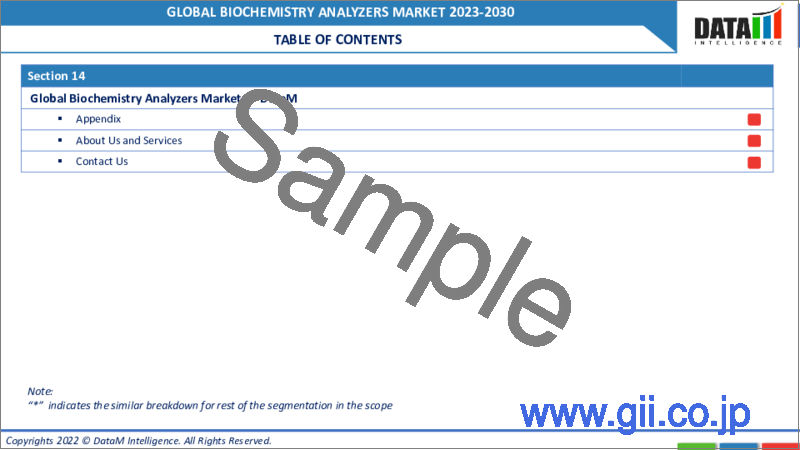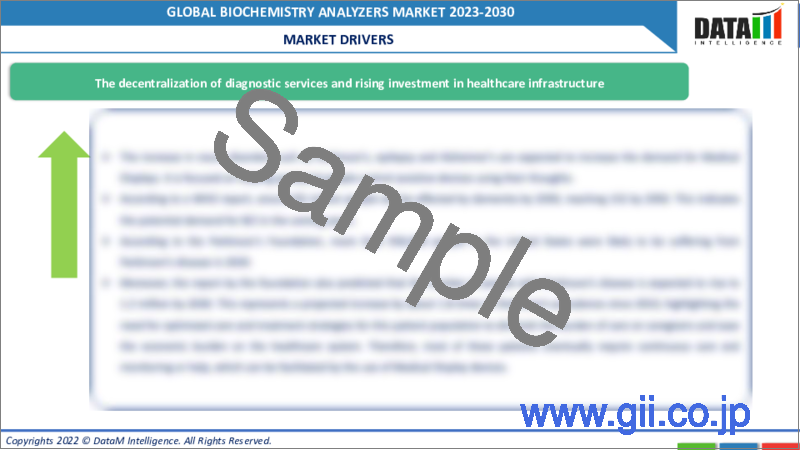|
|
市場調査レポート
商品コード
1176599
生化学分析装置の世界市場-2023-2030Global Biochemistry Analyzers Market - 2023-2030 |
||||||
|
● お客様のご希望に応じて、既存データの加工や未掲載情報(例:国別セグメント)の追加などの対応が可能です。 詳細はお問い合わせください。 |
|||||||
| 生化学分析装置の世界市場-2023-2030 |
|
出版日: 2022年12月26日
発行: DataM Intelligence
ページ情報: 英文 200 Pages
納期: 約2営業日
|
- 全表示
- 概要
- 目次
市場概要
生化学分析装置の世界市場規模は、予測期間(2023年~2030年)においてCAGR6.2%で成長すると予測されています。
生化学分析装置は、血液や尿を採取し、試薬を用いて反応を起こさせ、糖やコレステロールなど様々な成分を測定する装置です。これらの検査は、日常の健康診断や病院などで行われています。その結果、病気の早期発見や診断、治療効果や患者の予後を示す客観的なデータが得られます。
市場力学
生化学分析装置の市場は、糖尿病などの慢性疾患の患者数の増加、診断サービスの分散化、POCソリューションの需要増加、新興市場における医療インフラへの投資の増加などにより、拡大しています。
診断サービスの分散化とヘルスケア・インフラへの投資の高まりが、市場の成長を牽引すると予想されます。
生化学分析装置市場は、技術の進歩、POCソリューションの需要増加、研究開発投資の急増、糖尿病などの慢性疾患の増加、新興国市場における医療インフラの進歩に伴う最新技術を用いた新規製品の改善によって牽引されています。慢性疾患は世界中で数百万人が罹患しており、糖尿病だけでも4億2200万人が罹患していると言われています。これらの疾患の罹患者数が世界的に増加していることから、診断用検査の需要も増加する可能性があります。
技術の進歩により、生化学分析装置はより速く、より小さくなっています。ポータブルで小型の生化学分析装置が入手しやすくなったことで、医師はサンプルを大規模な研究所に送る代わりに、ポイントオブケア診断センターを設置することができるようになっています。
また、ポイントオブケア機器がカバーする疾患の数も増加しており、小型分析装置の需要が高まる可能性があります。これらの要因に加え、複数の疾患を確認するために生化学検査を行う必要性から、政府や民間企業によるヘルスケア支出の増加は、生化学分析装置などのインフラへの投資の増加につながる可能性があります。
さまざまな新規製品の発売や調査研究は、市場の成長に寄与しています。例えば、2022年5月13日、マインドレイは、BS-600M化学分析装置の発売を発表しました。このパワフルかつ効率的な分析装置は、効率性、信頼性、生産性を高めるために中規模ラボ向けに開発されました。連続的なサンプルローディングを可能にする高いスループットでコンパクトであり、堅牢な性能、優れた精度と正確さ、高いコスト効率を提供します。
生化学分析装置に関連する高い資本コストは、市場の成長を妨げると予想されます。
生化学分析装置の世界市場は、装置の高い資本コスト、一部の地域での保険償還額の減少、複雑なシステム統合を伴うため分析装置の使用経験のない人が管理できないため分析装置の管理に熟練した労働者の不足によって抑制されています。
生化学分析装置には多額の資本コストがかかります。ハイエンドの装置では45000ドルもします。このため、病院などのユーザーはレンタルで購入せざるを得なくなり、売上が減少しています。
COVID-19インパクト分析
このパンデミックは、世界の財務予測、オペレーション、危機対応戦略にプラスの影響を与えました。COVID-19の発生はヘルスケア産業に深刻な影響を与えました。生化学分析装置市場は、COVIDによって莫大な利益を経験しました。ウイルスによって肝臓障害や呼吸器疾患の発生率が上昇し、これらの生化学分析装置の需要につながったからです。主要メーカーは、様々な研究や臨床試験を開始しています。複数のイニシアチブ、製品の発売、コラボレーション、合併は、市場の成長を後押しし、世界中で起こっています。例えば、2021年11月3日、医療機器およびソリューションの開発およびサプライヤーであるMindrayは、新しい生化学パラメータを提供するために、体外診断会社Randoxとの提携を発表しました。
目次
第1章 調査手法と調査範囲
- 調査手法
- 調査目的および調査範囲
第2章 市場の定義と概要
第3章 エグゼクティブサマリー
第4章 市場力学
- 市場影響要因
- 促進要因
- 診断サービスの分散化
- ヘルスケアインフラへの投資拡大
- 技術的進歩の高まり
- 抑制要因
- 生化学自動分析装置に関する副作用について
- ビジネスチャンス
- 影響分析
- 促進要因
第5章 産業分析
- ポーターのファイブフォース分析
- サプライチェーン分析
- プライシング分析
- 規制分析
第6章 COVID-19の分析
- COVID-19の市場分析
- COVID-19以前の市場シナリオ
- COVID-19の現在の市場シナリオ
- COVID-19の後、または将来のシナリオ
- COVID-19の中での価格ダイナミクス
- 需要-供給スペクトラム
- パンデミック時の市場に関連する政府の取り組み
- メーカーの戦略的取り組み
- まとめ
第7章 タイプ別
- 全自動生化学分析装置
- 半自動生化学分析装置
第8章 構成別
- 卓上型生化学分析装置
- 床置き型生化学分析装置
第9章 容量別
- 小型生化学分析装置
- 中型生化学分析装置
- 大型生化学分析装置
第10章 アプリケーション別
- 臨床診断
- 医薬品開発
- バイオリアクター製品別検出
- その他
第11章 エンドユーザー別
- 病院
- 診断ラボ
- 製薬・バイオテクノロジー企業
- 研究機関
- その他
第12章 地域別
- 北米
- 米国
- カナダ
- メキシコ
- 欧州
- ドイツ
- 英国
- フランス
- イタリア
- スペイン
- その他欧州
- 南米
- ブラジル
- アルゼンチン
- その他の南米地域
- アジア太平洋地域
- 中国
- インド
- 日本
- オーストラリア
- その他アジア太平洋地域
- 中東・アフリカ地域
第13章 競合情勢
- 主な展開と戦略
- 企業シェア分析
- 製品ベンチマーク
- 注目の主要企業リスト
第14章 企業プロファイル
- F. Hoffmann-La Roche Ltd
- 企業概要
- 製品ポートフォリオと説明
- 主なハイライト
- 財務概要
- Beckman Coulter, Inc.
- Horiba Medical
- Siemens Healthineers AG
- Hitachi High-Tech Corporation
- EKF Diagnostics
- Thermo Fisher Scientific Inc.
- Shenzhen Mindray Bio-Medical Electronics Co., Ltd.
- Randox Laboratories Ltd.
- QuidelOrtho Corporation
第15章 生化学分析装置の世界市場-DataM
Market Overview
The global biochemistry analyzer market size was valued at US$ XX million in 2023 and is estimated to reach US$ XX million by 2030, growing at a CAGR of 6.2% during the forecast period (2023-2030).
The biochemistry analyzer is an instrument that uses a blood or urine sample and induces reactions using reagents to measure various components, such as sugar, cholesterol, etc. These tests are performed for routine health checks or at hospitals. The results provide objective data enabling early detection and diagnosis of disease and indicating the effects of treatment and patient prognosis.
Market Dynamics
The market for biochemistry analyzers is driven by the increase in the number of people affected with chronic diseases such as diabetes, decentralization of diagnostics services, increase in demand for POC solutions and the rising investment in healthcare infrastructure in emerging markets.
The decentralization of diagnostic services and rising investment in healthcare infrastructure are expected to drive the market's growth.
The biochemistry analyzers market is driven by rising advancements in technology, an increase in demand for POC solutions, a surge in research and development investments, an increasing number of chronic disorders such as diabetes, and improvements in novel products using the latest technology along with advances in medical infrastructure in emerging markets. Chronic diseases affect millions worldwide, with diabetes alone affecting 422 million people. With the number of people affected by these disorders increasing worldwide, the demand for diagnostic tests could increase.
Technological advances have resulted in biochemistry analyzers becoming faster and smaller. The rising availability of portable and smaller biochemistry analyzers has made it possible for physicians to set up their point-of-care diagnostic centers instead of sending the samples to large labs.
The number of diseases covered by point-of-care devices is also rising, thus potentially increasing the demand for small analyzers. Along with these factors, due to the necessity of performing biochemistry tests to confirm multiple disorders, rising healthcare expenditure by governments and the private sector could lead to higher investments in infrastructure such as biochemistry analyzers.
Various novel product launches and research studies contribute to the market's growth. For instance, in 13 May 2022, Mindray announced the launch of its BS-600M chemistry analyzer. This powerful yet efficient analyzer was developed for the medium size laboratories to enhance efficiency, reliability and productivity. It is compact with high throughput that allows continuous sample loading and provides robust performance, excellent precision and accuracy and high-cost efficiency.
The high capital cost associated with biochemistry analyzers is expected to hamper the market's growth.
The global market for biochemistry analyzers is restrained by the high capital cost of the machines, reduction in insurance reimbursement in some regions and shortage of skilled labor for managing the analyzers as they have complex system integration and hence can't be managed by a person without any experience of using these biochemical analyzers.
Biochemistry analyzers have a significant capital cost; high-end machines may cost as much as $45000. These high capital costs force users such as hospitals to acquire them on rental plans leading to lower sales.
COVID-19 Impact Analysis
The pandemic has positively impacted global financial expectations, operations and crisis response strategy. The COVID-19 outbreak has severely affected the healthcare industry. The biochemistry analyzers market has experienced huge profits due to COVID, as the incidence of liver disorders and respiratory disorders increased due to the virus leading to the demand for these biochemistry analyzers. Key manufacturers have started various research and clinical trials. Multiple initiatives, product launches, collaborations and mergers are happening worldwide, boosting the market's growth. For instance, in Nov 3, 2021, Mindray, medical devices and solutions developer and supplier, announced its partnership with in-vitro diagnostics company Randox to provide novel biochemistry parameters.
Segment Analysis
The fully automatic biochemistry analyzers-type segment is expected to grow at the fastest CAGR during the forecast period (2022-2029)
The fully automatic biochemistry analyzers type segment is the highest market holder in the global biochemistry analyzers market. The global biochemistry analyzers market is segmented based on type, as fully automated and semi-automatic biochemistry analyzers. The fully automatic biochemistry analyzers segment is the largest market shareholder due to its inherent advantages over semi-automatic analyzers, increasing technological advancements and novel product launches.
The fully automatic biochemistry analyzer is that samples can be processed in single, batches or continuously. In this type of analyzer, the instrument completes the whole process automatically, from sample addition to results. It only requires the operator to put the sample on the analyzer at a specific position and start the program without manual intervention. It is convenient, less time taking, has fewer measurement errors and provides quick analysis. To maintain product differentiation, key players are introducing new technologies, such as integrated and modular clinical chemistry analyzers, which perform the work of multiple machines at a faster rate.
The growing number of regulatory approvals, technological advancements, product launches, and research/clinical trial studies drive the market's growth. For instance, in July 22, 2020, Beckman Coulter announced that its novel PK7400 automated microplate system analyzer and its reagents had received U.S. Food and Drug Administration clearance. This analyzer can be utilized in blood donor centers and large laboratories. This system in this class provides high throughput for a single analyzer and processes around 300 samples per hour.
Geographical Analysis
North America holds the largest market share in the global biochemistry analyzers market.
North America dominates the global biochemistry analyzers market primarily due to its large population, excellent medical infrastructure, and high-income levels. The market is expected to grow at a relatively high pace during the forecast period due to healthcare expenditure in the US. The market's significant size is attributed to the high medical expenditure. The number of people affected with chronic disease is projected to rise to 629 million by 2045, as per the International Diabetes Federation. In the UK alone, 500 million biochemistry tests are performed yearly, with more than 50 % being for chronic diseases.
Increasing expenditure on healthcare and raising awareness among people is also contributing to the market's growth in this region. Advancement of applications of the biochemistry analyzers in several clinical diagnostics and drug development, increase in pharmaceutical establishment across the region and government approvals, and the presence of key players in the region are contributing to the growth of the biochemistry analyzers market.
Moreover, the growing number of product launches is responsible for the market's growth. Many key developments, technological advancements, collaborations, and agreements are taking place in this region. For instance, in January 25, 2021, Beckman Coulter, a clinical diagnostics provider, launched its tabletop analyzer, DxH 560 AL, which will minimize the small or medium-sized laboratory's resources and time constraints. This analyzer is compact and utilizes about 30% less space, offers auto-loading functionality and closed-tube aspiration capabilities, upto 50 samples can be added continually, takes less time on manual tasks and offers security against blood-borne microbes.
Competitive Landscape
The biochemistry analyzers market is highly competitive with local and global companies' presence. F. Hoffman-La Roche Ltd, Beckman Coulter, Inc., Horiba Medical, Siemens Healthineers AG, Hitachi High-Tech Corporation, EKF Diagnostics, Thermo Fisher Scientific Inc., Shenzhen Mindray Bio-Medical Electronics Co., Ltd., Randox Laboratories Ltd., QuidelOrtho Corporation and more. The key players are adopting various growth strategies such as product launches, mergers & acquisitions, partnerships, and collaborations, contributing to the market's growth. For instance, in December 23, 2021, Quidel Corporation, a point-of-care diagnostic solution manufacturer, announced its acquisition agreement completion with Ortho Clinical Diagnostics Holdings plc, an in vitro diagnostics company, to form QuidelOrtho.
F. Hoffman-La Roche Ltd.
Overview: Roche is a healthcare company that provides in-vitro diagnostics and supplies innovative and transformative solutions in various crucial disease areas. It works in two divisions: Pharmaceuticals and diagnostics. It was established in 1896 and is headquartered in Basel, Switzerland.
Product Portfolio:
Cobas 8000 analyzer series: These biochemistry analyzers are modular analyzers that provide a high-volume workload of over 500 samples daily with more than 440 configurations and 280 reagent positions.
Key Development: In Mar 16, 2022, Roche Diagnostics announced its partnership with SRL Diagnostics to transform its Fortis Memorial Research Institute laboratory with the integrated analyzer series of Roche.
The global biochemistry analyzers market report would provide access to approx.: 45+ market data tables, 40+ figures and 200 (approximate) pages.
Table of Contents
1. Methodology and Scope
- 1.1. Research Methodology
- 1.2. Research Objective and Scope of the Report
2. Market Definition and Overview
3. Executive Summary
4. Market Dynamics
- 4.1. Market Impacting Factors
- 4.1.1. Drivers
- 4.1.1.1. Decentralization of diagnostic services
- 4.1.1.2. Increasing investment in healthcare infrastructure
- 4.1.1.3. Rising technological advancements
- 4.1.2. Restraints:
- 4.1.2.1. Side effects associated with Biochemistry Analyzers
- 4.1.3. Opportunity
- 4.1.4. Impact Analysis
- 4.1.1. Drivers
5. Industry Analysis
- 5.1 Porter's Five Forces Analysis
- 5.2 Supply Chain Analysis
- 5.3 Pricing Analysis
- 5.4 Regulatory Analysis
6. COVID-19 Analysis
- 6.1. Analysis of Covid-19 on the Market
- 6.1.1. Before COVID-19 Market Scenario
- 6.1.2. Present COVID-19 Market Scenario
- 6.1.3. After COVID-19 or Future Scenario
- 6.2. Pricing Dynamics Amid Covid-19
- 6.3. Demand-Supply Spectrum
- 6.4. Government Initiatives Related to the Market During the Pandemic
- 6.5. Manufacturer's Strategic Initiatives
- 6.6. Conclusion
7. By Type
- 7.1. Introduction
- 7.1.1. Market Size Analysis and Y-o-Y Growth Analysis (%), By Type
- 7.1.2. Market Attractiveness Index, By Type
- 7.2. Fully Automatic Biochemistry Analyzers*
- 7.2.1. Introduction
- 7.2.2. Market Size Analysis US$ Million, 2020-2029 and Y-o-Y Growth Analysis (%), 2021-2029
- 7.3. Semi-Automatic Biochemistry Analyzers
8. By Configuration
- 8.1. Introduction
- 8.1.1. Market Size Analysis and Y-o-Y Growth Analysis (%), By Configuration
- 8.1.2. Market Attractiveness Index, By Configuration
- 8.2. Bench-Top Biochemistry Analyzers *
- 8.2.1. Introduction
- 8.2.2. Market Size Analysis US$ Million, 2020-2029 and Y-o-Y Growth Analysis (%), 2021-2029
- 8.3. Floor-Standing Biochemistry Analyzers
9. By Capacity
- 9.1. Introduction
- 9.1.1. Market Size Analysis and Y-o-Y Growth Analysis (%), By Capacity
- 9.1.2. Market Attractiveness Index, By Capacity
- 9.2. Small-Sized Biochemistry Analyzers *
- 9.2.1. Introduction
- 9.2.2. Market Size Analysis US$ Million, 2020-2029 and Y-o-Y Growth Analysis (%), 2021-2029
- 9.3. Medium-Sized Biochemistry Analyzers
- 9.4. Large-Sized Biochemistry Analyzers
10. By Application
- 10.1. Introduction
- 10.1.1. Market Size Analysis and Y-o-Y Growth Analysis (%), By Application
- 10.1.2. Market Attractiveness Index, By Application
- 10.2. Clinical Diagnostics *
- 10.2.1. Introduction
- 10.2.2. Market Size Analysis US$ Million, 2020-2029 and Y-o-Y Growth Analysis (%), 2021-2029
- 10.3. Drug Development
- 10.4. Bioreactor Byproduct Detection
- 10.5. Others
11. By End-User
- 11.1. Introduction
- 11.1.1. Market Size Analysis and Y-o-Y Growth Analysis (%), By End-User
- 11.1.2. Market Attractiveness Index, By End-User
- 11.2. Hospitals *
- 11.2.1. Introduction
- 11.2.2. Market Size Analysis US$ Million, 2020-2029 and Y-o-Y Growth Analysis (%), 2021-2029
- 11.3. Diagnostic Labs
- 11.4. Pharmaceutical and Biotechnology Companies
- 11.5. Research Institutions
- 11.6. Others
12. By Region
- 12.1. Introduction
- 12.1.1. Market Size Analysis US$ Million, 2020-2029 and Y-o-Y Growth Analysis (%), 2021-2029, By Region
- 12.1.2. Market Attractiveness Index, By Region
- 12.2. North America
- 12.2.1. Introduction
- 12.2.2. Key Region-Specific Dynamics
- 12.2.3. Market Size Analysis and Y-o-Y Growth Analysis (%), By Type
- 12.2.4. Market Size Analysis and Y-o-Y Growth Analysis (%), By Configuration
- 12.2.5. Market Size Analysis and Y-o-Y Growth Analysis (%), By Capacity
- 12.2.6. Market Size Analysis and Y-o-Y Growth Analysis (%), By Application
- 12.2.7. Market Size Analysis and Y-o-Y Growth Analysis (%), By End-User
- 12.2.8. Market Size Analysis and Y-o-Y Growth Analysis (%), By Country
- 12.2.8.1. U.S.
- 12.2.8.2. Canada
- 12.2.8.3. Mexico
- 12.3. Europe
- 12.3.1. Introduction
- 12.3.2. Key Region-Specific Dynamics
- 12.3.3. Market Size Analysis and Y-o-Y Growth Analysis (%), By Type
- 12.3.4. Market Size Analysis and Y-o-Y Growth Analysis (%), By Configuration
- 12.3.5. Market Size Analysis and Y-o-Y Growth Analysis (%), By Capacity
- 12.3.6. Market Size Analysis and Y-o-Y Growth Analysis (%), By Application
- 12.3.7. Market Size Analysis and Y-o-Y Growth Analysis (%), By End-User
- 12.3.8. Market Size Analysis and Y-o-Y Growth Analysis (%), By Country
- 12.3.8.1. Germany
- 12.3.8.2. U.K.
- 12.3.8.3. France
- 12.3.8.4. Italy
- 12.3.8.5. Spain
- 12.3.8.6. Rest of Europe
- 12.4. South America
- 12.4.1. Introduction
- 12.4.2. Key Region-Specific Dynamics
- 12.4.3. Market Size Analysis and Y-o-Y Growth Analysis (%), By Type
- 12.4.4. Market Size Analysis and Y-o-Y Growth Analysis (%), By Configuration
- 12.4.5. Market Size Analysis and Y-o-Y Growth Analysis (%), By Capacity
- 12.4.6. Market Size Analysis and Y-o-Y Growth Analysis (%), By Application
- 12.4.7. Market Size Analysis and Y-o-Y Growth Analysis (%), By End-User
- 12.4.8. Market Size Analysis and Y-o-Y Growth Analysis (%), By Country
- 12.4.8.1. Brazil
- 12.4.8.2. Argentina
- 12.4.8.3. Rest of South America
- 12.5. Asia Pacific
- 12.5.1. Introduction
- 12.5.2. Key Region-Specific Dynamics
- 12.5.3. Market Size Analysis and Y-o-Y Growth Analysis (%), By Type
- 12.5.4. Market Size Analysis and Y-o-Y Growth Analysis (%), By Configuration
- 12.5.5. Market Size Analysis and Y-o-Y Growth Analysis (%), By Capacity
- 12.5.6. Market Size Analysis and Y-o-Y Growth Analysis (%), By Application
- 12.5.7. Market Size Analysis and Y-o-Y Growth Analysis (%), By End-User
- 12.5.8. Market Size Analysis and Y-o-Y Growth Analysis (%), By Country
- 12.5.8.1. China
- 12.5.8.2. India
- 12.5.8.3. Japan
- 12.5.8.4. Australia
- 12.5.8.5. Rest of Asia Pacific
- 12.6. Middle East and Africa
- 12.6.1. Introduction
- 12.6.2. Key Region-Specific Dynamics
- 12.6.3. Market Size Analysis and Y-o-Y Growth Analysis (%), By Type
- 12.6.4. Market Size Analysis and Y-o-Y Growth Analysis (%), By Configuration
- 12.6.5. Market Size Analysis and Y-o-Y Growth Analysis (%), By Capacity
- 12.6.6. Market Size Analysis and Y-o-Y Growth Analysis (%), By Application
- 12.6.7. Market Size Analysis and Y-o-Y Growth Analysis (%), By End-User
13. Competitive Landscape
- 13.1. Key Developments and Strategies
- 13.2. Company Share Analysis
- 13.3. Products Benchmarking
- 13.4. List of Key Companies to Watch
14. Company Profiles
- 14.1. F. Hoffmann-La Roche Ltd *
- 14.1.1. Company Overview
- 14.1.2. Product Portfolio and Description
- 14.1.3. Key Highlights
- 14.1.4. Financial Overview
- 14.2. Beckman Coulter, Inc.
- 14.3. Horiba Medical
- 14.4. Siemens Healthineers AG
- 14.5. Hitachi High-Tech Corporation
- 14.6. EKF Diagnostics
- 14.7. Thermo Fisher Scientific Inc.
- 14.8. Shenzhen Mindray Bio-Medical Electronics Co., Ltd.
- 14.9. Randox Laboratories Ltd.
- 14.10. QuidelOrtho Corporation
LIST NOT EXHAUSTIVE
15. Global Biochemistry Analyzers Market - DataM
- 15.1. Appendix
- 15.2. About Us and Application
- 15.3. Contact Us




